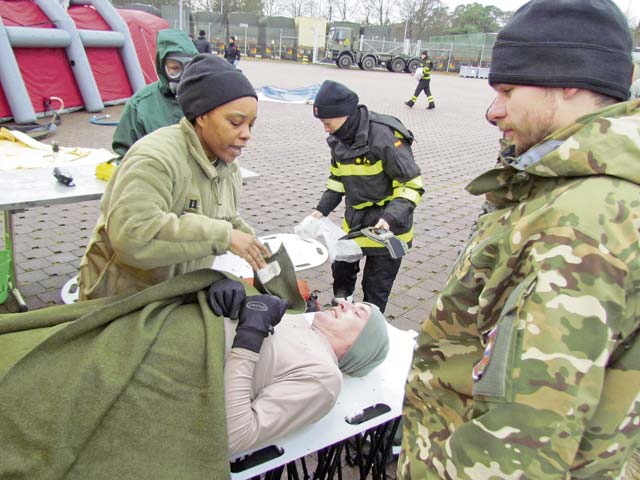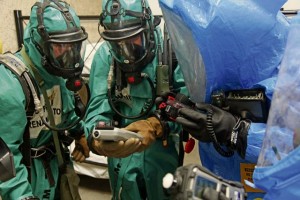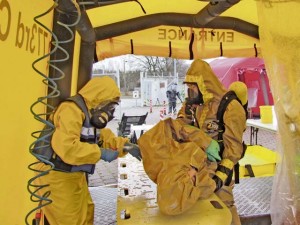
Despite cold and rainy conditions, Soldiers from three countries recently trained together to improve their ability to respond to chemical, biological, radiological and nuclear threats.
A team from Spain’s “Unidad Militar de Emergencias,” which translates to “Military Emergencies Unit,” joined the Army Reserve’s 773rd Civil Support Team and members of the Slovenian army for the weeklong CBRN exercise Ocean Response.
“For us, it’s a real opportunity to work together to improve,” said Lt. Col. Carlos Armada, Spanish UME chief. “We’re really happy to be here.”

Both the 773rd CST and the UME use NATO protocols and procedures, Armada said. Collaborating in a focused exercise leaves both teams ready to face a CBRN incident, Armada added.
“I am very happy to be here, and I am open to collaborating again, anytime, anywhere,” Armada said.
The exercise continued the relationship first built during exercise Daimel 2015 in Spain last year. Both units conduct similar CBRN response missions.
“They are a capable partner, and we both learn from each other,” said Lt. Col. U.L. Armstrong Jr., 773rd CST commander.
Although there are some differences between the units, there are many similar capabilities as well, Armstrong said.
“The way they proceed through a problem might be a little differently than the United States would proceed through the problem,” said Lt. Col. Michael Ballerstein, 773rd CST deputy commander.
During Ocean Response, the teams conducted training at American facilities in Baumholder and Miesau before heading to Rhine Ordnance Barracks for the culminating event.
The weather in Germany was just above freezing, and the strong wind and light rain made conditions frigid for the outdoor part of the exercise. It was much colder than the soldiers from Spain were used to.
“We normally don’t work in these kinds of weather conditions,” said Cpl. Adrian Leadbeater, UME member.
In Spain they usually see temperatures around 20 degrees Celsius, which is about 68 degrees Fahrenheit, Leadbeater added.
“The Spanish Army can work through it,” Leadbeater said. “It’s not an obstacle.”

The scenario required the CBRN responders to conduct a CBRN rescue and decontamination outside. Then they entered a nearby warehouse for training on detection, sampling and identification missions.
The Spanish and American teams suited up and worked side by side, conducting all the tasks together.
“We like working with the United States Army,” Leadbeater said. “We have the same principles.”
The whole week of interoperability training was valuable, Armada said.
At Baumholder, the Spanish UME staged their mobile laboratory. There are no others in Europe quite like it, offering both advanced field-testing capabilities and communication technology to increase interoperability, Armada said.
The mobile laboratory was not involved in the training at ROB, but the teams did get a chance to learn about it during the rest of the week.
“One of the many objectives in this kind of training is working together for the future,” Armada said. “We are ready to work together in the future.”
The 773rd CST and the UME will be working together again in April in Spain during the consequence management exercise Gamma 16.


